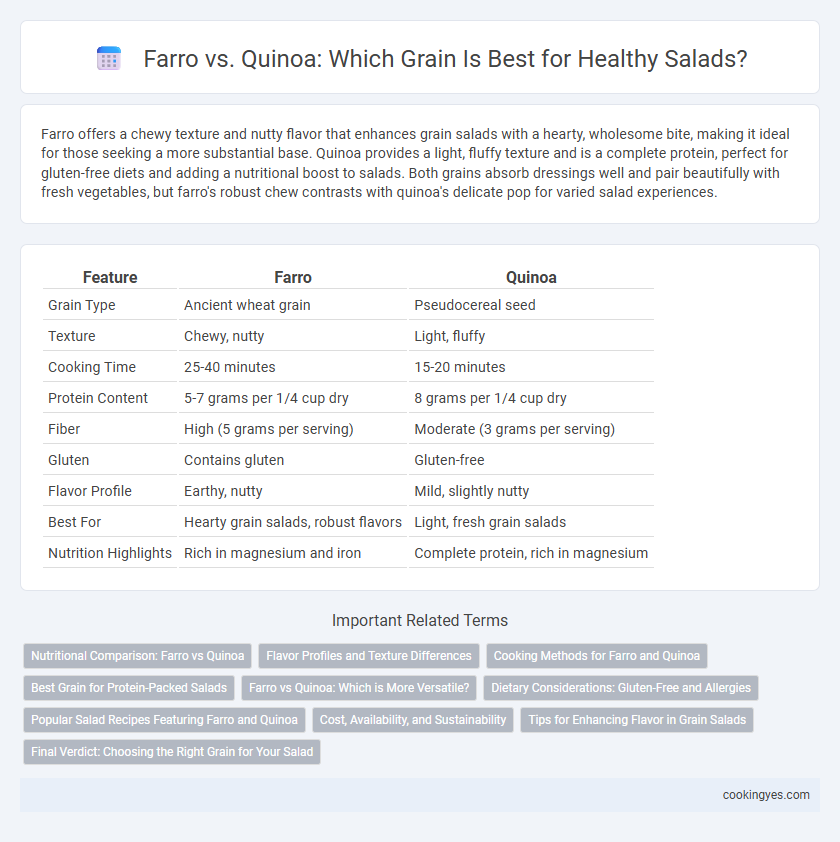Farro offers a chewy texture and nutty flavor that enhances grain salads with a hearty, wholesome bite, making it ideal for those seeking a more substantial base. Quinoa provides a light, fluffy texture and is a complete protein, perfect for gluten-free diets and adding a nutritional boost to salads. Both grains absorb dressings well and pair beautifully with fresh vegetables, but farro's robust chew contrasts with quinoa's delicate pop for varied salad experiences.
Table of Comparison
| Feature | Farro | Quinoa |
|---|---|---|
| Grain Type | Ancient wheat grain | Pseudocereal seed |
| Texture | Chewy, nutty | Light, fluffy |
| Cooking Time | 25-40 minutes | 15-20 minutes |
| Protein Content | 5-7 grams per 1/4 cup dry | 8 grams per 1/4 cup dry |
| Fiber | High (5 grams per serving) | Moderate (3 grams per serving) |
| Gluten | Contains gluten | Gluten-free |
| Flavor Profile | Earthy, nutty | Mild, slightly nutty |
| Best For | Hearty grain salads, robust flavors | Light, fresh grain salads |
| Nutrition Highlights | Rich in magnesium and iron | Complete protein, rich in magnesium |
Nutritional Comparison: Farro vs Quinoa
Farro offers higher protein and fiber content compared to quinoa, making it a nutrient-dense choice for grain salads. Quinoa provides a complete amino acid profile with more essential minerals like magnesium and iron. Both grains support digestive health and sustained energy, but quinoa is gluten-free, catering to dietary restrictions.
Flavor Profiles and Texture Differences
Farro offers a nutty, slightly sweet flavor with a chewy, dense texture that holds well in grain salads, adding a hearty bite. Quinoa has a mild, earthy taste with a fluffy, light texture that easily absorbs dressings, making it versatile for diverse salad flavors. Choosing between farro and quinoa depends on desired salad consistency, with farro providing a robust chew and quinoa contributing a softer, airy contrast.
Cooking Methods for Farro and Quinoa
Farro requires simmering in water or broth for 25-40 minutes until tender but chewy, often soaked beforehand to reduce cooking time. Quinoa cooks faster, typically boiling for 12-15 minutes, absorbing water completely to become fluffy and light. Both grains benefit from rinsing to remove bitterness and enhance texture in grain salads.
Best Grain for Protein-Packed Salads
Farro offers a higher protein content than quinoa, with approximately 7 grams of protein per cooked half-cup compared to quinoa's 4 grams, making it a superior choice for protein-packed grain salads. Its nutty flavor and chewy texture enhance salad complexity while providing essential nutrients like fiber, iron, and magnesium. Quinoa, although slightly lower in protein, remains a complete protein source with all nine essential amino acids and is naturally gluten-free, ideal for those with dietary restrictions.
Farro vs Quinoa: Which is More Versatile?
Farro offers a chewy texture and nutty flavor that complements Mediterranean-style grain salads, while quinoa provides a lighter, fluffy consistency with a mild taste ideal for diverse salad combinations. Quinoa's gluten-free nature and faster cooking time increase its versatility for gluten-sensitive diets and quick meal prep. Farro's hearty structure enhances salads with robust ingredients, making it preferable for rustic, protein-rich dishes.
Dietary Considerations: Gluten-Free and Allergies
Quinoa is naturally gluten-free and well-suited for individuals with celiac disease or gluten intolerance, making it a safer option for grain salads targeting gluten-sensitive diets. Farro contains gluten, which can trigger allergic reactions or digestive issues in people with gluten allergies or sensitivities, limiting its use in allergen-conscious meal planning. When selecting grains for salads, quinoa's hypoallergenic properties and high protein content provide a nutritious alternative without compromising dietary restrictions.
Popular Salad Recipes Featuring Farro and Quinoa
Farro and quinoa are both nutrient-dense grains frequently featured in popular salad recipes like Mediterranean farro salad with cherry tomatoes and kale or quinoa tabbouleh with cucumbers and fresh herbs. Farro offers a chewy texture and nutty flavor that complements roasted vegetables and vinaigrette dressings, while quinoa provides a light, fluffy consistency packed with complete protein ideal for grain bowls and mixed greens. These grains enhance salad recipes by adding fiber, protein, and a hearty base that supports vibrant toppings such as chickpeas, feta cheese, and citrus vinaigrettes.
Cost, Availability, and Sustainability
Farro is often more affordable than quinoa, with prices averaging around $3-$5 per pound compared to quinoa's $5-$7 per pound, making it a budget-friendly choice for grain salads. Farro's availability is increasing in grocery stores but remains less widespread than quinoa, which is commonly found in most supermarkets worldwide due to its global popularity. From a sustainability perspective, farro is considered more eco-friendly because it requires less water and synthetic fertilizers than quinoa, which is typically grown in the Andean region and has contributed to environmental strain from intensive farming practices.
Tips for Enhancing Flavor in Grain Salads
To enhance flavor in farro and quinoa grain salads, roast farro before cooking to bring out its nutty taste and toast quinoa to reduce bitterness and add depth. Incorporate fresh herbs like parsley, mint, or cilantro along with citrus zest and juice to brighten the salad's profile. Use high-quality olive oil and a splash of vinegar or lemon juice to balance the grains' earthy notes and create a vibrant, well-rounded salad.
Final Verdict: Choosing the Right Grain for Your Salad
Farro offers a nutty flavor and chewy texture that holds up well in hearty salads, providing a rich source of fiber and protein. Quinoa delivers a lighter, fluffy texture with a complete amino acid profile, ideal for gluten-free options and quick preparation. Selecting between farro and quinoa depends on dietary needs and desired texture, with farro better suited for robust meals and quinoa for versatile, nutrient-dense salads.
Farro vs Quinoa for grain salads Infographic

 cookingyes.com
cookingyes.com